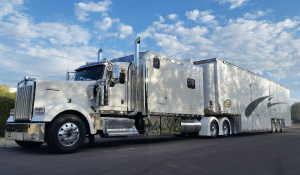Factors To Consider When Budgeting For Cross-Country Car Shipping
When planning to ship your car cross-country, it is crucial to consider various factors that can impact your budget. Understanding these factors will help you plan and allocate your finances effectively.
Firstly, the distance between the pick-up and drop-off locations plays a significant role in determining the cost of shipping. The longer the distance, the higher the expense is likely to be. Additionally, if your route includes remote or hard-to-reach areas, it may result in additional charges.
Secondly, the type of vehicle you own will affect the cost of shipping. Larger vehicles or those with non-standard dimensions may require specialized carriers or equipment, leading to higher shipping costs.
Furthermore, the chosen shipping method can influence your budget. Open transport is generally more affordable compared to enclosed transport but offers less protection from external elements.
The time of year also impacts pricing due to supply and demand fluctuations within the industry. Peak seasons like summer often result in higher rates as demand surges.
Lastly, it’s important to consider any extra services you might require during transportation such as expedited delivery or additional insurance coverage.
By considering these factors when budgeting for cross-country car shipping, you can better estimate costs and ensure a smoother financial planning process for this significant undertaking.
Researching And Comparing Car Shipping Companies For Cost-Efficiency
When it comes to shipping your car cross-country, finding a cost-efficient car shipping company is crucial. To ensure you get the best deal, it is essential to research and compare different options. Start by gathering information about various car shipping companies. Look for reputable companies with positive customer reviews and a track record of delivering cars safely and on time. Consider factors such as their experience in the industry, licensing, and insurance coverage.
Next, obtain quotes from multiple car shipping companies. Provide them with accurate details about your vehicle, including its make, model, dimensions, and destination. This will help the companies provide you with an accurate estimate. As you compare quotes, don’t solely focus on the price. Take into account other factors such as delivery timelines and any additional services offered by each company.
Some may provide door-to-door delivery or allow you to track your vehicle throughout the journey. Additionally, consider seasonal fluctuations in prices. Shipping during off-peak times may result in lower costs due to reduced demand. Lastly, read through each company’s terms and conditions carefully before making a decision. Look for any hidden fees or restrictive clauses that may affect your budget.
Tips For Saving Money On Cross-Country Car Shipping Services
When it comes to shipping your car cross-country, finding affordable options can make a significant difference in your budget. Here are some valuable tips and tricks for saving money on cross-country car shipping services. 1. Plan ahead: Booking your car shipment well in advance allows you to explore different options and compare prices. Last-minute bookings can often be more expensive. 2.
Research multiple companies: Don’t settle for the first company you come across. Take the time to research and obtain quotes from various auto transport companies. Compare their prices, services, and customer reviews to find the most cost-effective option without compromising on quality. 3. Choose open transport: While enclosed trailers offer extra protection, they tend to be pricier than open carriers. If your vehicle doesn’t require added protection or if you’re comfortable with minimal exposure during transit, opting for an open carrier can save you money.
4. Consider terminal-to-terminal shipping: Door-to-door service is convenient but can be more expensive due to additional labor costs involved. Opting for terminal-to-terminal shipping, where you drop off and pick up your vehicle at specified terminals, can help reduce expenses. 5. Be flexible with dates: Some auto transport companies offer discounts for flexible pick-up or delivery dates since they can combine shipments along similar routes, optimizing their efficiency and reducing costs.
Hidden Costs To Watch Out For When Shipping Your Car Across The Country
When it comes to shipping your car across the country, there are several hidden costs that you should be aware of to ensure your budgeting is accurate. First and foremost, it’s essential to consider the distance of the journey. The longer the distance, the higher the cost will likely be. Additionally, keep in mind that fuel prices can fluctuate along your route, potentially affecting your budget.
Another hidden cost to watch out for is insurance coverage. While most reputable auto transport companies provide insurance, it’s crucial to review their policies thoroughly and understand what they cover. In some cases, you may need to purchase additional insurance to protect against any potential damages during transit. Furthermore, some shipping companies may charge extra fees for specific services or circumstances.
For instance, if your vehicle is oversized or modified in any way, additional charges may apply. Similarly, if you require expedited shipping or want enclosed transportation for added protection, these options often come with a higher price tag. Lastly, don’t forget about potential delays due to unforeseen circumstances such as weather conditions or mechanical issues. These delays could result in additional expenses like accommodations and meals while waiting for your car’s arrival.
Budget-Friendly Strategies For Preparing Your Vehicle Before Cross-Country Shipping
Preparing your vehicle for cross-country shipping doesn’t have to be an expensive endeavor. By following some budget-friendly strategies, you can ensure your car is ready for the journey without breaking the bank.
Firstly, consider giving your car a thorough cleaning yourself instead of opting for professional detailing services. Cleaning the interior and exterior of your vehicle will not only make it more presentable but also allow you to inspect it closely for any existing damages that need documentation. Additionally, removing personal items from the car will help reduce weight and minimize the risk of damage during transportation.
Next, rather than relying on mechanics or dealerships for routine maintenance tasks, perform basic checks yourself. These may include checking tire pressure, fluid levels, and ensuring all lights are functioning properly. If there are minor issues that need fixing, such as replacing a broken tail light or a worn-out wiper blade, consider purchasing inexpensive parts online and installing them yourself.
Lastly, take photographs of your vehicle from various angles before shipping it as evidence of its pre-existing condition. This documentation can help protect you in case any damages occur during transit.
By adopting these budget-friendly strategies, you can save money while still adequately preparing your vehicle for cross-country shipping.













